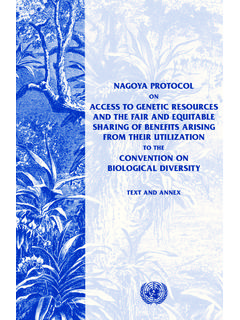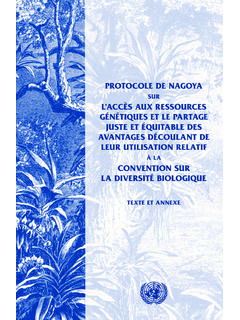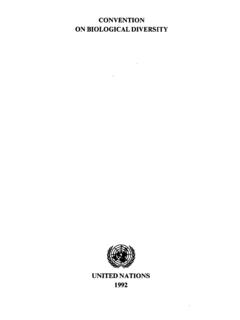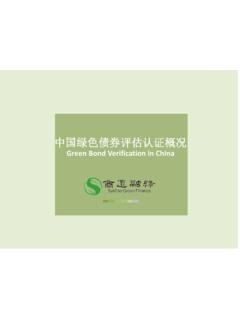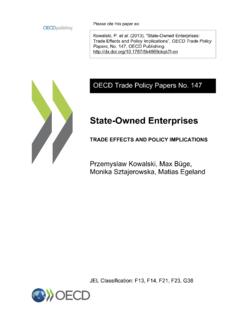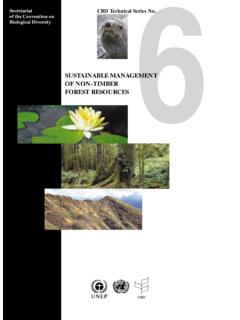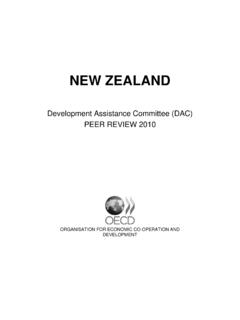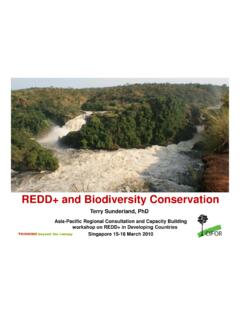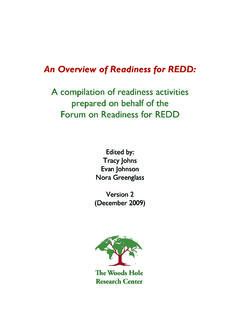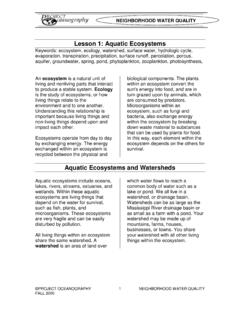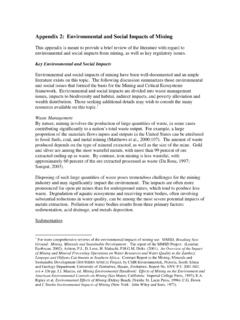Transcription of Wetlands and Ecosystem Services
1 CBD Press Brief and Ecosystem ServicesWetlands are unique, productive ecosystems where terrestrial and aquatic habitats meet. Wetlands play a critical role in maintaining many natural cycles and supporting a wide range of biodiversity. They purify and replenish our water, and provide the fish and rice that feed billions. They serve as a natural sponge against flooding and drought, protect our coastlines and help fight climate change. Bursting with biodiversity, wet-lands are a vital means of storing carbon. Wetlands are also tremendously productive ecosystems that provide a myriad of Services to society worldwide. Wetlands are particularly important providers of all water-related Ecosystem Services . They regulate wa-ter quantity, groundwater recharge, and can contribute to regulating floods and the impacts of storms. Wetlands also help in erosion control and sediment transport, thereby contributing to land formation and increasing resilience to storms.
2 All these Ecosystem Services improve water security, including security from natural hazards and climate change adaptation. The final Rio+20 outcome document, The Future We Want , inter alia, recognised the role of ecosystems in the supply of water and its are productive areas for plant life, animals and wetland agriculture. Compared to many other ecosystems , Wetlands are one of the most productive habitats in the world. With greater species diversity nutrient recycling and niche specialization than most other are the major habitat for most of the world s waterbirds and key habitat for migratory species. Almost all of the world s waterbirds use Wetlands as feeding and breeding grounds. Migratory waterbirds use Wetlands throughout their range which can sometimes literally be from pole to pole. The feeding, breeding and stop-over areas across and between continents that migratory birds depend on requires co-ordinated Wetlands conservation efforts among many nations.
3 Wetlands are an important source of food. Well-managed rice paddy systems, for example, produce not only rice but also co-benefits from rice-associated biodiversity, such as highly nutritious food in the form of fish, molluscs and crustaceans. Wetlands also support the multitude of biota that helps sustain rice produc-tivity through supporting nutrient cycling and pest and disease regulation. The entire production of inland capture fisheries and most coastal fisheries is derived from Wetlands , as is most aquaculture Wetlands DayWetlands for our FutureMonday, 2 February 2015 Secretariat of the Convention on Biological Diversity413, Saint Jacques Street, suite 800 Montreal, Quebec, H2Y 1N9 CanadaTel.: +1 514 288 2220 Fax: +1 514 288 6588 of coastal and inland Wetlands Ecosystem Services are typically higher than for other Ecosystem types. Wetland ecosystems can have some of the highest Ecosystem service values compared to other ecosystems .
4 This is due to the importance of clean water provision, natural hazards mitigation, for exam-ple mangrove forests and floodplains, and carbon storage, for example in peatlands, mangroves and tidal marshes. A large proportion of the values reported for most types of Wetlands come from their water-related have high recreational, historical, scientific, and cultural values. Wetlands have played an im-portant part in human development and are of significant religious, historical or archeological value to many cultures around the world. They are also often inviting places for popular recreational activities in-cluding hiking, fishing, bird watching, photography and sourced from the Ramsar Convention on Wetlands and the Secretariat of the Convention on Biological DiversityFor additional information, please contact: David Ainsworth at +1 514 287 7025 or Hedlund at +1 514 287 6670 or links Convention on Biological Diversity: Strategic Plan for Biodiversity 2011-2020 and the Aichi Biodiversity Targets: CBD Programme of Work on Inland Waters Biodiversity: Global Biodiversity Outlook 4: Convention on Wetlands of International Importance (Ramsar Convention): World Wetlands Day 2015: Convention on the Conservation of Migratory Species of Wild Animals: Open Working Group proposal for Sustainable Development Goals: CBD Press Brief Meeting the Challenges of the FutureThe future of humanity depends on Wetlands .
5 Wetlands are some of the most important biodiverse areas in the world. Many of the challenges of the future can be met through conserving and sustainably using Wetlands , such as food and water security, human health, disaster risk reduction and climate change resil-ience. However, Wetlands are experiencing rapid decline. Newly-published estimates show that 64 % of the world s Wetlands have disappeared since 1900. In Asia, the loss is even higher. This means that access to fresh water is eroding for 1 -2 billion people worldwide, while flood control, carbon storage and traditional wetland livelihoods all suffer. Biodiversity has also been affected, as populations of freshwater species have declined by 76 % between 1970 and 2010 according to WWF s Living Planet of wetland loss. Often viewed as wastelands to be drained, filled and converted to other purposes, the main causes of Wetlands loss and degradation include major changes in land use, especially an increase in agriculture and grazing and urban infrastructure development, air and water pollution and excess nutri-ents, and water diversion (dams, dikes and canalization).
6 Wetlands ensure fresh water for us all. Only some 3 % of the world s water is fresh, with most of that fro-zen. Only 1% of that, or of total water, is available for direct use by people. Yet every human needs 20-50 litres of water a day for basic drinking, cooking and cleaning with astronomically higher requirements to grow the food eaten. Wetlands provide that water, and help replenish groundwater purify and filter harmful waste from water. Plants from Wetlands help absorb harmful fertilizers and pesticides, as well as heavy metals and toxins from industry. The Nakivubo Swamp in Kampala, Uganda, for example, filters sewage and industrial effluents for free; a treatment plant would cost $2 million per feed humanity. Rice, grown in wetland paddies, is the staple diet of nearly three billion people. The average human consumes 19 kg of fish each year. Most commercial fish breed and raise their young in coastal marshes and estuaries. 70 % of all fresh water extracted globally is for crop Wetlands DayWetlands for our FutureMonday, 2 February 2015 Secretariat of the Convention on Biological Diversity413, Saint Jacques Street, suite 800 Montreal, Quebec, H2Y 1N9 CanadaTel.
7 : +1 514 288 2220 Fax: +1 514 288 6588 burst with biodiversity. Wetlands are home to over 100,000 known freshwater species. That number is growing. In just 10 years, 272 new species of freshwater fish were discovered in the Amazon alone. Wetlands are essential to bird life, breeding and act as nature s sponges. Peatlands, wet grasslands and floodplains in river basins act as natural sponges by absorbing rainfall and creating wide surface pools that ease flooding in rivers. The same storage capacity can also safeguard against help fight climate change. Peatlands alone store more than twice as much carbon as all the world s forests. Faced with rising sea levels, coastal Wetlands reduce the impact of typhoons and tsunamis. They also bind the shoreline and resist provide sustainable livelihoods and products. Some 62 million people depend directly on fishing and fisheries for a living. Timber for building, vegetable oil, medicinal plants, animal fodder, and stems and leaves for weaving can all originate from sustainably managed sourced from the Ramsar Convention on Wetlands and the Secretariat of the Convention on Biological DiversityFor additional information, please contact: David Ainsworth at +1 514 287 7025 or Hedlund at +1 514 287 6670 or links Convention on Biological Diversity: Strategic Plan for Biodiversity 2011-2020 and the Aichi Biodiversity Targets: CBD Programme of Work on Inland Waters Biodiversity: Global Biodiversity Outlook 4: Convention on Wetlands of International Importance (Ramsar Convention): World Wetlands Day 2015: Open Working Group proposal for Sustainable Development Goals.
8 CBD Press Brief and the Sustainable Development GoalsThe sustainable use of water and Wetlands , by protecting the Services they provide, is critical to enable so-ciety to achieve sustainable social and economic development, adapt to climate change and improve social cohesion and economic proposed United Nations Sustainable Development Goals (SDGs) offer a universal agenda that, for the first time, recognises the need for restoration and management of water-related ecosystems , including Wetlands , as a basis for addressing water scarcity and water risks. Wetlands are a solution for several key challenges around the world related to water, food and climate, and key to meeting the SDGs. Most of the proposed SDGs are relevant in some way or another to Wetlands , but the following are of particular importance:Goal 2: End hunger, achieve food security and improved nutrition and promote sustainable agricultureRice grown in wetland paddies is the staple diet of nearly three billion people.
9 The average human con-sumes 19 kg of fish each year. Most commercial fish breed and raise their young in coastal marshes and estuaries. 70 % of all fresh water extracted globally is used for crop 6: Ensure availability and sustainable management of water and sanitation for all Wetlands ensure fresh water, help replenish ground aquifers, and purify and filter harmful waste from wa-ter such as fertilizers and pesticides, as well heavy metals and toxins from 11: Make cities and human settlements inclusive, safe, resilient and sustainableWetlands act as natural sponges absorbing rainfall, providing protection against coastal and river flooding to (partially) offset the need for man-made infrastructure. They also help reduce drought, protect coastal areas for fisheries nurseries and regulate sediment transport thereby contributing to land formation and coastal zone 13: Take urgent action to combat climate change and its impactsWetlands act as carbon sinks.
10 Peatlands alone store more than twice as much as all the world s forests. Coastal Wetlands reduce the impact of rising sea levels, acting as storm surge buffers and providing erosion control. World Wetlands DayWetlands for our FutureMonday, 2 February 2015 Secretariat of the Convention on Biological Diversity413, Saint Jacques Street, suite 800 Montreal, Quebec, H2Y 1N9 CanadaTel.: +1 514 288 2220 Fax: +1 514 288 6588 14: Conserve and sustainably use the oceans, seas and marine resources for sustainable develop-mentWithout Wetlands , the water cycle, carbon cycle and nutrient cycles would be significantly altered. Water cycles, essentially the continuous movement of water on, above and below the surface of the Earth, are of critical importance to biodiversity and to the functioning of virtually all terrestrial and coastal Wetlands are important for sustaining seas and marine resources, for example as nursery grounds for many marine fisheries.
